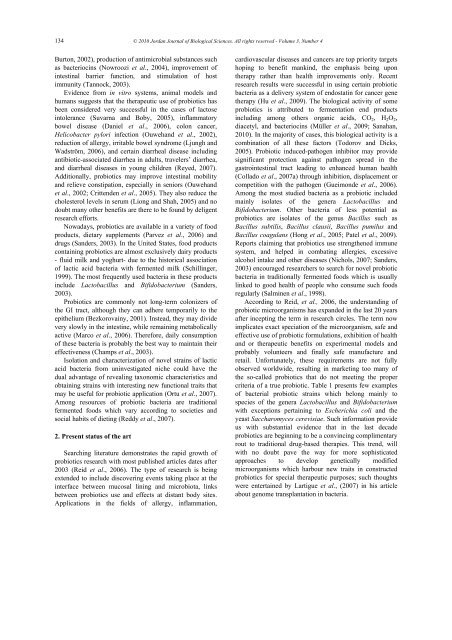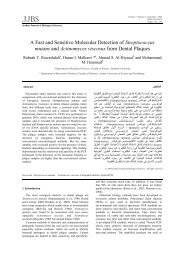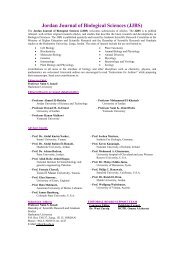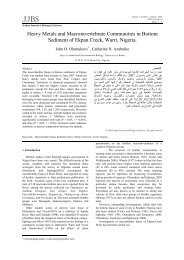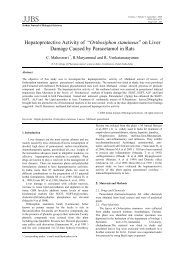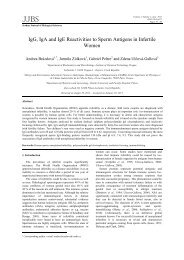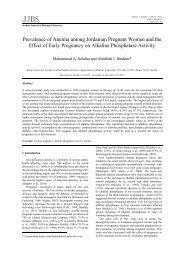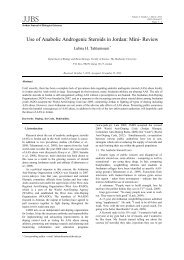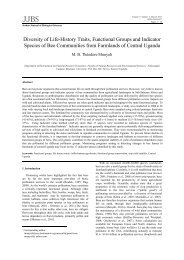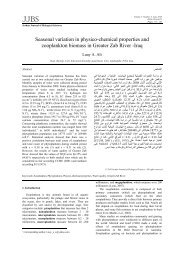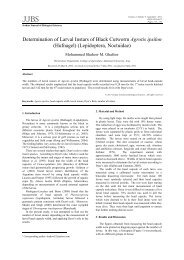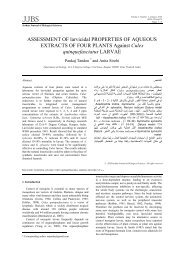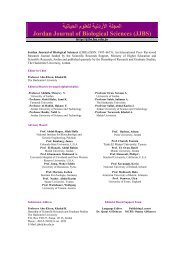Number 4 - Jordan Journal of Biological Sciences
Number 4 - Jordan Journal of Biological Sciences
Number 4 - Jordan Journal of Biological Sciences
You also want an ePaper? Increase the reach of your titles
YUMPU automatically turns print PDFs into web optimized ePapers that Google loves.
134<br />
© 2010 <strong>Jordan</strong> <strong>Journal</strong> <strong>of</strong> <strong>Biological</strong> <strong>Sciences</strong>. All rights reserved - Volume 3, <strong>Number</strong> 4<br />
Burton, 2002), production <strong>of</strong> antimicrobial substances such<br />
as bacteriocins (Nowroozi et al., 2004), improvement <strong>of</strong><br />
intestinal barrier function, and stimulation <strong>of</strong> host<br />
immunity (Tannock, 2003).<br />
Evidence from in vitro systems, animal models and<br />
humans suggests that the therapeutic use <strong>of</strong> probiotics has<br />
been considered very successful in the cases <strong>of</strong> lactose<br />
intolerance (Suvarna and Boby, 2005), inflammatory<br />
bowel disease (Daniel et al., 2006), colon cancer,<br />
Helicobacter pylori infection (Ouwehand et al., 2002),<br />
reduction <strong>of</strong> allergy, irritable bowel syndrome (Ljungh and<br />
Wadström, 2006), and certain diarrheal disease including<br />
antibiotic-associated diarrhea in adults, travelers’ diarrhea,<br />
and diarrheal diseases in young children (Reyed, 2007).<br />
Additionally, probiotics may improve intestinal mobility<br />
and relieve constipation, especially in seniors (Ouwehand<br />
et al., 2002; Crittenden et al., 2005). They also reduce the<br />
cholesterol levels in serum (Liong and Shah, 2005) and no<br />
doubt many other benefits are there to be found by deligent<br />
research efforts.<br />
Nowadays, probiotics are available in a variety <strong>of</strong> food<br />
products, dietary supplements (Parvez et al., 2006) and<br />
drugs (Sanders, 2003). In the United States, food products<br />
containing probiotics are almost exclusively dairy products<br />
- fluid milk and yoghurt- due to the historical association<br />
<strong>of</strong> lactic acid bacteria with fermented milk (Schillinger,<br />
1999). The most frequently used bacteria in these products<br />
include Lactobacillus and Bifidobacterium (Sanders,<br />
2003).<br />
Probiotics are commonly not long-term colonizers <strong>of</strong><br />
the GI tract, although they can adhere temporarily to the<br />
epithelium (Bezkorovainy, 2001). Instead, they may divide<br />
very slowly in the intestine, while remaining metabolically<br />
active (Marco et al., 2006). Therefore, daily consumption<br />
<strong>of</strong> these bacteria is probably the best way to maintain their<br />
effectiveness (Champs et al., 2003).<br />
Isolation and characterization <strong>of</strong> novel strains <strong>of</strong> lactic<br />
acid bacteria from uninvestigated niche could have the<br />
dual advantage <strong>of</strong> revealing taxonomic characteristics and<br />
obtaining strains with interesting new functional traits that<br />
may be useful for probiotic application (Ortu et al., 2007).<br />
Among resources <strong>of</strong> probiotic bacteria are traditional<br />
fermented foods which vary according to societies and<br />
social habits <strong>of</strong> dieting (Reddy et al., 2007).<br />
2. Present status <strong>of</strong> the art<br />
Searching literature demonstrates the rapid growth <strong>of</strong><br />
probiotics research with most published articles dates after<br />
2003 (Reid et al., 2006). The type <strong>of</strong> research is being<br />
extended to include discovering events taking place at the<br />
interface between mucosal lining and microbiota, links<br />
between probiotics use and effects at distant body sites.<br />
Applications in the fields <strong>of</strong> allergy, inflammation,<br />
cardiovascular diseases and cancers are top priority targets<br />
hoping to benefit mankind, the emphasis being upon<br />
therapy rather than health improvements only. Recent<br />
research results were successful in using certain probiotic<br />
bacteria as a delivery system <strong>of</strong> endostatin for cancer gene<br />
therapy (Hu et al., 2009). The biological activity <strong>of</strong> some<br />
probiotics is attributed to fermentation end products<br />
including among others organic acids, CO2, H 2O 2,<br />
diacetyl, and bacteriocins (Müller et al., 2009; Sanahan,<br />
2010). In the majority <strong>of</strong> cases, this biological activity is a<br />
combination <strong>of</strong> all these factors (Todorov and Dicks,<br />
2005). Probiotic induced-pathogen inhibitor may provide<br />
significant protection against pathogen spread in the<br />
gastrointestinal tract leading to enhanced human health<br />
(Collado et al., 2007a) through inhibition, displacement or<br />
competition with the pathogen (Gueimonde et al., 2006).<br />
Among the most studied bacteria as a probiotic included<br />
mainly isolates <strong>of</strong> the genera Lactobacillus and<br />
Bifidobacterium. Other bacteria <strong>of</strong> less potential as<br />
probiotics are isolates <strong>of</strong> the genus Bacillus such as<br />
Bacillus subtilis, Bacillus clausii, Bacillus pumilus and<br />
Bacillus coagulans (Hong et al., 2005; Patel et al., 2009).<br />
Reports claiming that probiotics use strengthened immune<br />
system, and helped in combating allergies, excessive<br />
alcohol intake and other diseases (Nichols, 2007; Sanders,<br />
2003) encouraged researchers to search for novel probiotic<br />
bacteria in traditionally fermented foods which is usually<br />
linked to good health <strong>of</strong> people who consume such foods<br />
regularly (Salminen et al., 1998).<br />
According to Reid, et al., 2006, the understanding <strong>of</strong><br />
probiotic microorganisms has expanded in the last 20 years<br />
after incepting the term in research circles. The term now<br />
implicates exact speciation <strong>of</strong> the microorganism, safe and<br />
effective use <strong>of</strong> probiotic formulations, exhibition <strong>of</strong> health<br />
and or therapeutic benefits on experimental models and<br />
probably volunteers and finally safe manufacture and<br />
retail. Unfortunately, these requirements are not fully<br />
observed worldwide, resulting in marketing too many <strong>of</strong><br />
the so-called probiotics that do not meeting the proper<br />
criteria <strong>of</strong> a true probiotic. Table 1 presents few examples<br />
<strong>of</strong> bacterial probiotic strains which belong mainly to<br />
species <strong>of</strong> the genera Lactobacillus and Bifidobacterium<br />
with exceptions pertaining to Escherichia coli and the<br />
yeast Saccharomyces cerevisiae. Such information provide<br />
us with substantial evidence that in the last decade<br />
probiotics are beginning to be a convincing complimentary<br />
rout to traditional drug-based therapies. This trend, will<br />
with no doubt pave the way for more sophisticated<br />
approaches to develop genetically modified<br />
microorganisms which harbour new traits in constructed<br />
probiotics for special therapeutic purposes; such thoughts<br />
were entertained by Lartigue et al., (2007) in his article<br />
about genome transplantation in bacteria.


